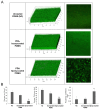Pentadecanoic Acid-Releasing PDMS: Towards a New Material to Prevent S. epidermidis Biofilm Formation
- PMID: 39409056
- PMCID: PMC11476977
- DOI: 10.3390/ijms251910727
Pentadecanoic Acid-Releasing PDMS: Towards a New Material to Prevent S. epidermidis Biofilm Formation
Abstract
Microbial biofilm formation on medical devices paves the way for device-associated infections. Staphylococcus epidermidis is one of the most common strains involved in such infections as it is able to colonize numerous devices, such as intravenous catheters, prosthetic joints, and heart valves. We previously reported the antibiofilm activity against S. epidermidis of pentadecanoic acid (PDA) deposited by drop-casting on the silicon-based polymer poly(dimethyl)siloxane (PDMS). This material exerted an antibiofilm activity by releasing PDA; however, a toxic effect on bacterial cells was observed, which could potentially favor the emergence of resistant strains. To develop a PDA-functionalized material for medical use and overcome the problem of toxicity, we produced PDA-doped PDMS by either spray-coating or PDA incorporation during PDMS polymerization. Furthermore, we created a strategy to assess the kinetics of PDA release using ADIFAB, a very sensitive free fatty acids fluorescent probe. Spray-coating resulted in the most promising strategy as the concentration of released PDA was in the range 0.8-1.5 μM over 21 days, ensuring long-term effectiveness of the antibiofilm molecule. Moreover, the new coated material resulted biocompatible when tested on immortalized human keratinocytes. Our results indicate that PDA spray-coated PDMS is a promising material for the production of medical devices endowed with antibiofilm activity.
Keywords: ABIFAB; PDMS; S. epidermidis; antibiofilm; pentadecanoic acid; surface coating.
Conflict of interest statement
The authors declare no conflicts of interest.
Figures





Similar articles
-
Pentadecanal and pentadecanoic acid coatings reduce biofilm formation of Staphylococcus epidermidis on PDMS.Pathog Dis. 2020 Apr 1;78(3):ftaa012. doi: 10.1093/femspd/ftaa012. Pathog Dis. 2020. PMID: 32105313
-
Slippery Liquid-Like Solid Surfaces with Promising Antibiofilm Performance under Both Static and Flow Conditions.ACS Appl Mater Interfaces. 2022 Feb 9;14(5):6307-6319. doi: 10.1021/acsami.1c14533. Epub 2022 Jan 31. ACS Appl Mater Interfaces. 2022. PMID: 35099179 Free PMC article.
-
Dual-function antimicrobial-antibiofilm peptide hybrid to tackle biofilm-forming Staphylococcus epidermidis.Ann Clin Microbiol Antimicrob. 2024 May 16;23(1):44. doi: 10.1186/s12941-024-00701-7. Ann Clin Microbiol Antimicrob. 2024. PMID: 38755634 Free PMC article.
-
Antibiofilm activity of three Actinomycete strains against Staphylococcus epidermidis.Lett Appl Microbiol. 2019 Jan;68(1):73-80. doi: 10.1111/lam.13087. Epub 2018 Nov 22. Lett Appl Microbiol. 2019. PMID: 30338533 Review.
-
Staphylococcus aureus and Staphylococcus epidermidis infections on implants.J Hosp Infect. 2018 Feb;98(2):111-117. doi: 10.1016/j.jhin.2017.11.008. Epub 2017 Nov 22. J Hosp Infect. 2018. PMID: 29175074 Review.
References
MeSH terms
Substances
LinkOut - more resources
Full Text Sources

